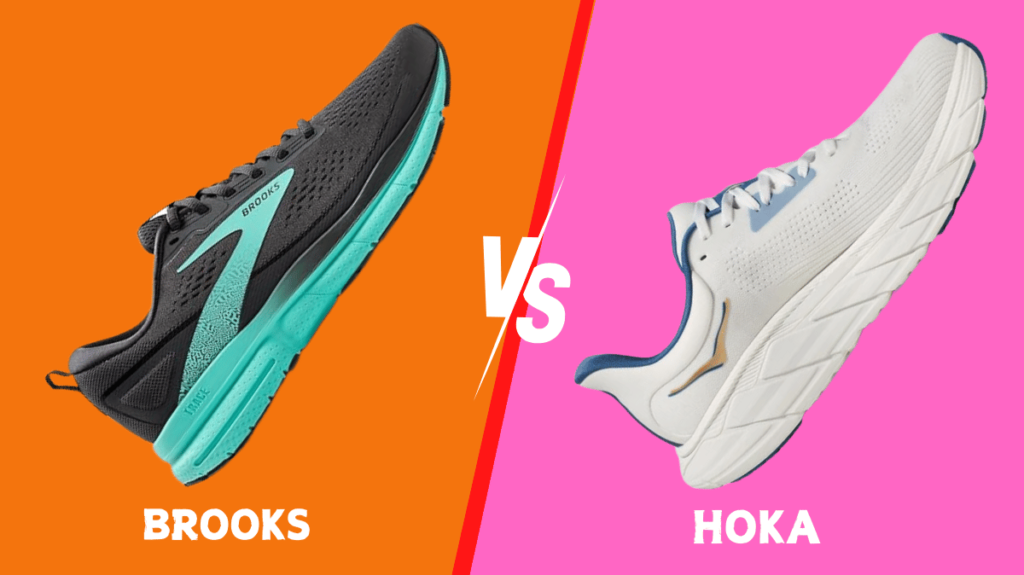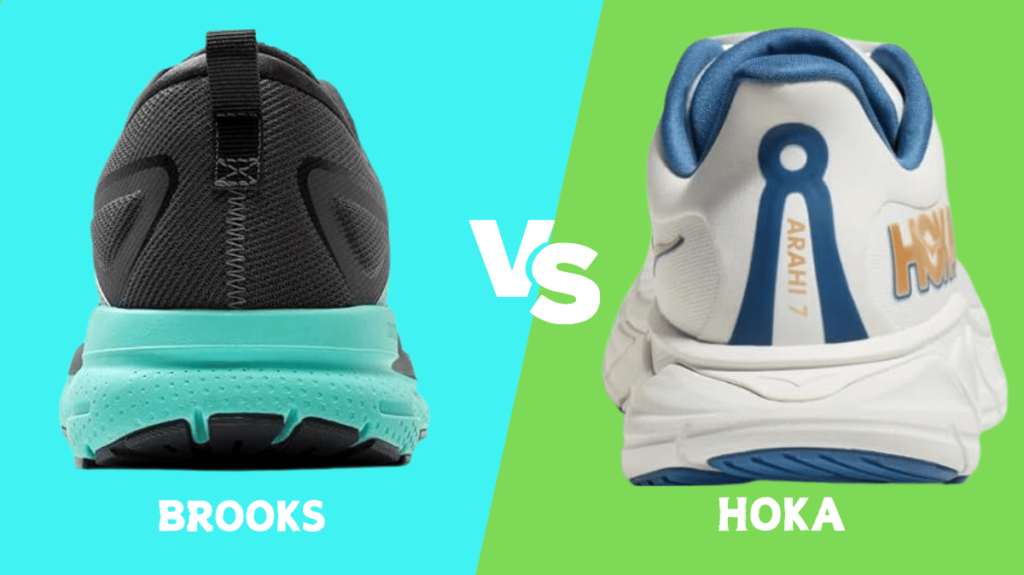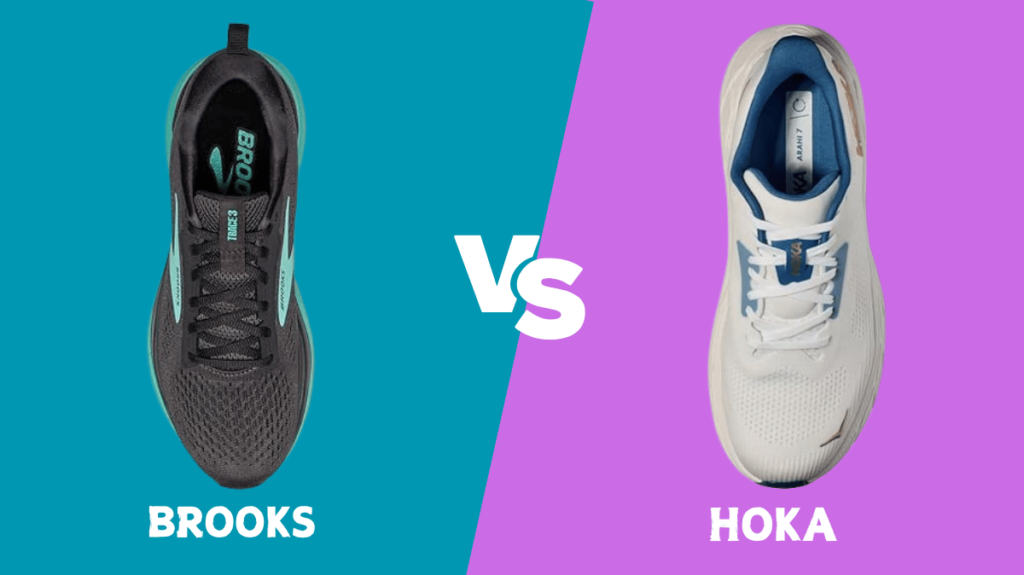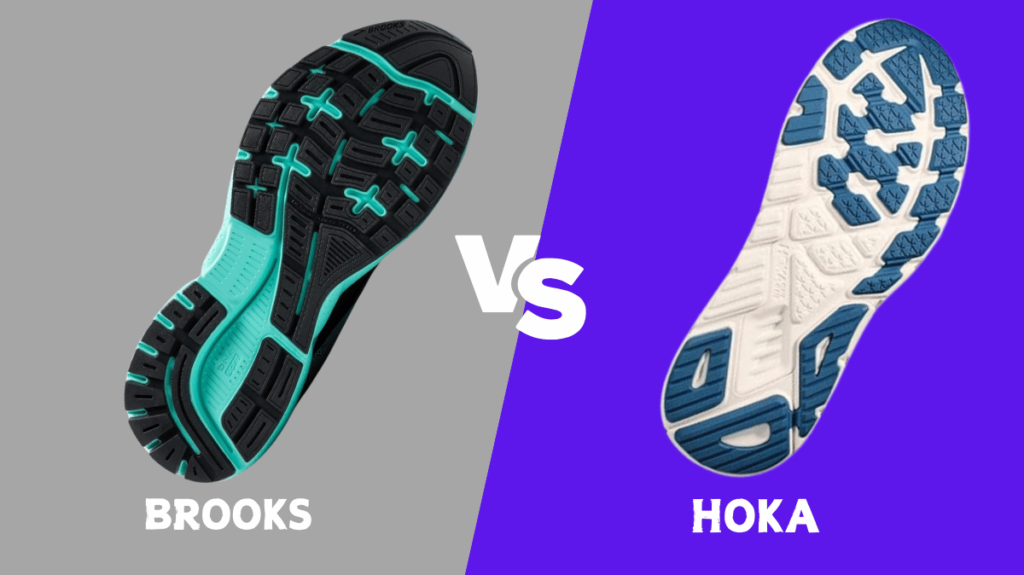Physical Address
304 North Cardinal St.
Dorchester Center, MA 02124
Physical Address
304 North Cardinal St.
Dorchester Center, MA 02124
Choosing the right running shoes is essential for both comfort and performance. When it comes to Brooks Shoes vs Hoka, two popular brands in the running world, many people wonder which one is the best. Both brands offer top-quality shoes, but they differ in design, comfort, and other important features. In this article, we will compare Brooks shoes vs Hoka in terms of comfort, style, sizing, breathability, durability, fit, and pricing. This guide will help you decide which brand is better for your needs. Let’s dive in!

| Category | Brooks | Hoka |
| Comfort | Balanced cushioning, supports stability, great for overpronation | Plush, extra-thick cushioning, best for reducing fatigue |
| Design | Traditional, classic, understated | Bold, modern, chunky soles, bright color options |
| Sizing | Consistent sizing across models, wide options available | Roomier toe box, slightly inconsistent sizing |
| Breathability | Excellent airflow with engineered mesh uppers | Good ventilation, but thicker soles can trap more heat |
| Durability | 300-500 miles, long-lasting materials | 250-400 miles, slightly softer but durable materials |
| Fit and Support | Snug fit with focus on stability, great for overpronators | Roomier fit, more relaxed, cushioned for comfort |
| Pricing | $120-$160, good value for money | $130-$170, slightly more expensive but worth the comfort |
Brooks shoes are known for their cushioning and balanced support. Their shoes, like the Brooks Ghost and Brooks Glycerin, use DNA LOFT and BioMoGo DNA technology. These features give a soft but responsive feel, making long runs easier. Brooks is also famous for providing stability and motion control, especially for those with overpronation (where the foot rolls inward).
Brooks shoes are ideal for runners who prefer a more structured, stable feel. The cushioning adapts to the shape of your foot, reducing stress on joints. This is especially beneficial for runners who need extra support during long runs or those who tend to have foot pain.
Hoka shoes are famous for their extra-thick cushioning, which provides a plush and soft running experience. Shoes like the Hoka Clifton and Hoka Bondi have a unique Meta-Rocker design that helps with smooth transitions. The foam midsoles are thicker than many other brands, giving a “walking on clouds” sensation.
Hoka is great for runners who prioritize maximum cushioning. The shoes are excellent for long-distance runners who want to reduce fatigue and impact on their legs and feet. While some may find the thick soles odd at first, many runners grow to love the plush comfort.
| Feature | Brooks | Hoka |
|---|---|---|
| Cushioning | Soft and balanced | Plush and extra thick |
| Best For | Stability and support | Maximum comfort and shock absorption |
| Tech | DNA LOFT, BioMoGo DNA | Meta-Rocker, EVA foam midsoles |
Brooks shoes have a more traditional running shoe design, appealing to runners who want simple, classic-looking shoes. Their design usually focuses on function over flash. While Brooks has added some sleek designs and colorways over time, they are often viewed as understated compared to other brands.
Hoka shoes stand out due to their chunky soles and unique shapes. These bold designs appeal to runners who like their shoes to have a bit of personality. With a variety of bright colors and thick midsoles, Hoka shoes look modern and futuristic. This makes Hoka popular among both athletes and casual wearers who appreciate their distinctive style.
| Aspect | Brooks | Hoka |
|---|---|---|
| Design Style | Traditional and classic | Bold and modern |
| Colors | Subtle, neutral tones | Bright, eye-catching options |
| Sole Thickness | Regular | Extra thick, maximalist |

The most noticeable difference between Brooks shoes vs Hoka is the amount of cushioning. Brooks offers a more balanced approach, focusing on stability and structured support, whereas Hoka prioritizes soft, plush comfort with its thick midsoles. Another big difference is in the design. Brooks shoes are traditional, while Hoka’s design is more modern and noticeable.
Both brands cater to different types of runners:
Brooks is known for its consistent sizing. Whether you are buying a new pair of Brooks Ghost or switching to another model like the Adrenaline, you can generally expect the same fit across their shoes. This is a huge plus for runners who don’t like having to try on multiple sizes. Brooks also offers a wide range of widths, which is beneficial for people with wider or narrower feet.
Hoka shoes can sometimes run a bit wider, especially in the toe box. This can be good for runners who need more room for their toes. However, some users have found that Hoka sizing can vary slightly between models. It’s a good idea to try them on or carefully check reviews before purchasing, especially if you’re buying a different model than usual.
| Feature | Brooks | Hoka |
|---|---|---|
| Sizing | Consistent across models | Can vary slightly across models |
| Width Options | Available in narrow, regular, wide | Roomier toe box, but fewer widths |
Brooks has been around for over a century and is known for its focus on running. They are a go-to brand for runners of all levels, from beginners to seasoned marathoners. Brooks shoes are highly regarded for their durability and long-lasting comfort. Their commitment to quality makes them a trusted brand in the running community.
Hoka is a newer brand, founded in 2009, but it has quickly gained a strong reputation, especially among long-distance runners and trail runners. Hoka shoes are known for innovation, and their unique designs are praised for reducing impact and offering unmatched comfort. Despite being a younger brand, Hoka has a loyal following and continues to grow in popularity.
| Brand | Brooks | Hoka |
|---|---|---|
| Reputation | Trusted, long-established brand | Innovative, fast-growing brand |
| Focus | Running stability, durability | Comfort, cushioning, and innovation |
Brooks shoes often use engineered mesh in their uppers, which allows for decent airflow. This helps keep your feet cool and dry, even during long runs. Models like the Brooks Ghost are especially known for their breathability.
Hoka also uses mesh uppers, but due to the thicker sole design, the shoes may feel a bit warmer compared to Brooks. However, most Hoka models still offer good ventilation, and the brand continues to innovate to improve airflow in their designs.

Brooks shoes are built to last, with most models offering around 300 to 500 miles of running before needing replacement. The materials used in Brooks shoes, like the durable rubber outsoles and high-quality cushioning, make them ideal for runners who need a long-lasting shoe.
Hoka shoes, while comfortable, may wear out a bit faster than Brooks due to their softer cushioning. On average, Hoka shoes last around 250 to 400 miles. However, some runners find that the extra comfort is worth the slightly shorter lifespan.
| Feature | Brooks | Hoka |
|---|---|---|
| Durability | 300-500 miles | 250-400 miles |
| Materials | Durable rubber, strong mesh uppers | Softer foam, still durable |
Brooks shoes are designed to provide a snug but comfortable fit. The combination of cushioning and support helps with stability, making Brooks a great choice for those with overpronation. Brooks shoes cradle the foot, providing security during runs.
Hoka shoes are known for their roomier toe box and cushioned feel. This makes them a great option for those who prefer a more relaxed fit or have wider feet. Hoka shoes are supportive, but the focus is more on comfort than structure.
Brooks shoes are typically priced between $120 and $160, depending on the model. This makes them affordable for most runners, especially considering their durability and performance. Brooks shoes offer great value for money, making them a popular choice.
Hoka shoes are slightly more expensive, usually ranging from $130 to $170. The higher price tag reflects the extra cushioning and innovative design. While Hoka shoes may cost more upfront, many runners feel the comfort is worth the price.
Brooks shoes receive high ratings for their comfort, support, and durability. Many customers appreciate how long-lasting the shoes are and the consistent fit across models. Some common feedback includes the shoes’ ability to reduce foot pain and provide excellent support during long runs.
Hoka shoes also receive glowing reviews, especially from runners who prefer soft, plush cushioning. Many customers praise the comfort and how the shoes help reduce joint and muscle fatigue. However, some users mention that the thick soles take some getting used to.
| Feature | Brooks | Hoka |
|---|---|---|
| Pricing | $120-$160 | $130-$170 |
| Customer Ratings | High ratings for stability and durability | High ratings for comfort and cushioning |

Both Brooks Sheos vs Hoka are excellent brands, each with unique strengths. Brooks is ideal for runners who need stability, support, and long-lasting shoes. Hoka is perfect for runners seeking maximum comfort and soft cushioning. Choosing between the two depends on your personal preferences, running style, and foot needs.
Hoka is often better for long-distance running due to its thick cushioning, which reduces fatigue. However, Brooks also offers great options for distance runners, especially if you need stability.
Yes, Brooks offers a range of widths, making them a great option for people with wide or narrow feet.
Hoka shoes may wear out slightly faster due to their softer cushioning, but they still offer great durability for the comfort they provide.
Brooks is generally a bit more affordable than Hoka, but both offer high-quality running shoes that are worth the investment.